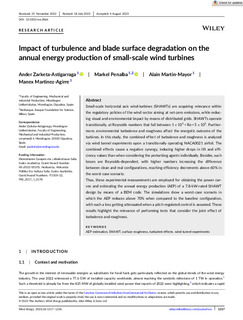Izenburua
Impact of turbulence and blade surface degradation on the annual energy production of small-scale wind turbinesArgitalpen data
2023Dokumentu-mota
ArtikuluaBertsio argitaratuaHizkuntza
IngelesaEskubideak
© 2023 The AuthorsSarbidea
Sarbide irekiaArgitaratzailearen bertsioa
https://doi.org/10.1002/we.2866Non argitaratua
Wind Energy Vol. 26. N. 12. Pp. 1217-1234Argitaratzailea
WileyGako-hitzak
AEP estimation
SHAWT
surface roughness
ODS 7 Energía asequible y no contaminante ... [+]
SHAWT
surface roughness
ODS 7 Energía asequible y no contaminante ... [+]
AEP estimation
SHAWT
surface roughness
ODS 7 Energía asequible y no contaminante
ODS 11 Ciudades y comunidades sostenibles
ODS 12 Producción y consumo responsables
turbulent effects
wind tunnel experiments [-]
SHAWT
surface roughness
ODS 7 Energía asequible y no contaminante
ODS 11 Ciudades y comunidades sostenibles
ODS 12 Producción y consumo responsables
turbulent effects
wind tunnel experiments [-]
Laburpena
Small-scale horizontal axis wind-turbines (SHAWTs) are acquiring relevance withinthe regulatory policies of the wind sector aiming at net-zero emissions, while reduc-ing visual and environmental impac ... [+]
Small-scale horizontal axis wind-turbines (SHAWTs) are acquiring relevance withinthe regulatory policies of the wind sector aiming at net-zero emissions, while reduc-ing visual and environmental impact by means of distributed grids. SHAWTs operatetransitionally, at Reynolds numbers that fall between 1 105<Re<5 105. Further-more, environmental turbulence and roughness affect the energetic outcome of theturbines. In this study, the combined effect of turbulence and roughness is analysedvia wind tunnel experiments upon a transitionally operating NACA0021 airfoil. Thecombined effects cause a negative synergy, inducing higher drops in lift and effi-ciency values than when considering the perturbing agents individually. Besides, suchlosses are Reynolds-dependent, with higher numbers increasing the differencebetween clean and real configurations, reaching efficiency decrements above 60% inthe worst-case scenario.Thus, these experimental measurements are employed for obtaining the power cur-ves and estimating the annual energy production (AEP) of a 7.8-kW-rated SHAWTdesign by means of a BEM code. The simulations show a worst-case scenario inwhich the AEP reduces above 70% when compared to the baseline configuration,with such a loss getting attenuated when a pitch-regulated control is assumed. Theseresults highlight the relevance of performing tests that consider the joint effect ofturbulence and roughness. [-]
Bildumak
Item honek honako baimen-fitxategi hauek dauzka asoziatuta:






















